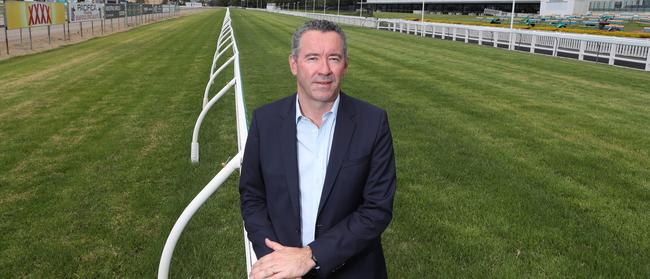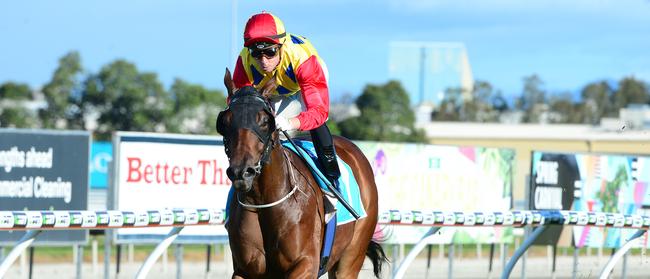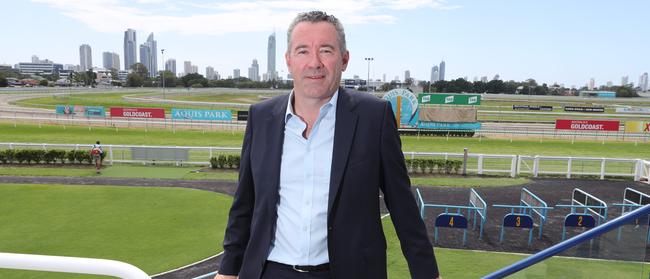Racing Queensland CEO Brendan Parnell weighs in on all the big issues facing the industry on the Gold Coast and state
BRENDAN Parnell has vast experience in racing and business and he needed every bit of it to negotiate his way through tough times early in his tenure as Racing Queensland CEO. Parnell weighs in on plans for the Gold Coast, night racing, programming and the return of harness and greyhound racing in this week’s Q&A.
Racing
Don't miss out on the headlines from Racing. Followed categories will be added to My News.
BRENDAN Parnell has vast experience in racing and business and he needed every bit of it to negotiate his way through tough times early in his tenure as Racing Queensland CEO.
And it’s not over yet with the Gold Coast racing industry still waiting for a track upgrade.
Gold Coast trainers are becoming frustrated watching upgrades to Eagle Farm, Toowoomba and Sunshine Coast while nothing happens to their track. When can we see some work?
We are hoping to begin work in 2019, potentially in the early stages of the year, on the training tracks and lights. All going well it could be completed by 2020. There is $28 million allocated to it from the (racing scheme) and we are eager to get started. Any projects worth over $1 million need to be signed off individually by the government. The outage at Eagle Farm has held that up but with that on the mend we can now look to start putting our focus on the Gold Coast.

How much work has been done into synthetic tracks as you decide what to use at the Gold Coast for their training track?
We actually did a tour recently of a few synthetic tracks in southern states and different materials work in different weather conditions. We had Gold Coast’s Steve Andrews and (race manager) James Cable do the tour with us along with some Sunshine Coast club officials and trainers. There has been concern in the past with material coming off the track but they are well more advanced now and like all things, need to be maintained properly.
GET FULL DIGITAL ACCESS FOR 50C A DAY
When do you aim to have all the track infrastructure, including track, lights and tunnel completed along with the new race program across the state?
We hope we will have the infrastructure in place and the everything up and going across all the tracks by 2022.
When the Gold Coast has lights for night racing, what will that enable you to do with your programming?
We would start our meetings one or two races later and finish a bit later into the evening. We have trialled the later timeslot at a couple of meetings already this year and had terrific results.
We found the late afternoon races were attracting a larger turnover which will only mean more funds for things like prizemoney down the track. We currently can do Toowoomba and Sunshine Coast under lights and have plans for Gold Coast to be lit.
As we do more night racing in Queensland, it will free up some day timeslots. Most prominently those will be Friday, Saturday and Sundays. That will help us in our bid to have those country race meetings as TAB-meetings. We will likely give the country racing clubs a needed boost with prizemoney next time around after providing funding for the metro and provincial clubs already this year.
Gold Coast want to become the third metropolitan track. How many more of those meetings will they host going forward?
We haven’t got an exact figure on it but looking to increase it. The lights will enable us to spread meetings across Toowoomba, Sunshine Coast and Gold Coast and potentially Doomben. The traditional midweek metro has been held on a Wednesday but we are open to changing it.

How does increasing TAB-covered country meetings benefit everyone?
In Queensland almost 40 per cent of our thoroughbred race meetings are non-tabs currently. That is the highest percentage in Australia by a long way. The little once-a-year clubs play a critical social role out in those communities. It’s really important that is maintained and the government is supporting that funding. There are a number of other clubs that have big cup days or major events that have good field sizes. If we can switch more of their non-TABs to TABS we can bring wagering revenue back into racing so we can distribute more prizemoney.
You have had a busy opening period since you became Racing Queensland CEO in April, with the Eagle Farm track drama and strike action. What have you learnt about the industry?
It is very important that everyone in the racing industry is aligned. The strike action showed that the industry is at its most powerful when everyone is pulling in the same direction. It was really encouraging to see all the stakeholders in racing working together to achieve such a great result. It was great of the government to commit funding through the point of consumption tax that was being introduced but it just wasn’t done in the right way. It wasn’t going to be distributed in a way that would benefit the industry the way it should. We were working very hard in the background but the groundswell of support and exposure in the media made the government stand up and take notice. Thankfully, Eagle Farm is on its way back after a lot of work over the past 12 months and it’s ability to host racing again will benefit everyone.

Racing Queensland pushed provincial prizemoney up to $21,000 recently. It stopped the flood of trainers heading south of the border but it’s still lower than country NSW racing. Do you plan to increase it further soon?
The plan will be about working with government. The second stage of prizemoney grants, which we choose how it’s distributed, is being negotiated with the government. There are a whole lot of reform measures we have got to work through. Being more commercial as an organisation and finding new ways to earn revenue to support racing is critical. That can include things like converting non-TAB races to TAB meetings so they actually earn revenue for racing. If we can unlock that the government is due to provide an additional $8 million in April per annum so we will then work through how much of that goes to prizemoney. We may seek to take some costs out for owners and trainers to make it cheaper to race horses here. It’s not just about prizemoney but how we can make racing more viable.
Part of the point of consumption tax funding was promised to harness and greyhound racing who are still trying to find a new home after losing their Southport base due to the Commonwealth Games held this year. They lost their land and to a site that became the athletes village. How is that search going?
We have narrowed the potential sites for harness and greyhound racing to four sites and we could have a decision early in the new year. The sites are located between the Gold Coast and Brisbane and Brisbane and western areas. There is $120 million in the racing infrastructure fund (RIF) and some of it will be used to find new homes for the harness and greyhound fraternity. It doesn’t look like we will be able to replicate the Southport precinct and have both greyhound and harness racing on the same site. They will be separated and there could be a potential third site used. We will likely only have a one-turn greyhound track.
BRENDAN PARNELL BIO:
Age: 51
Position: Racing Queensland CEO
Previous roles:
■ Almost three decades in broadcast media, sports, betting and international trade.
■ Holds Graduate Certificate of Management and Bachelor of Arts (Journalism).
■ Began career as news and sports reporter at Seven Network, Queensland. Network sports editor until 1995.
■ Led Tabcorp’s media business Sky Racing from 2007 for seven years after general management roles from 2003.
■ Former managing director for Tabcorp International, overseeing the internationalisation of racing and betting.
■ Was chief executive officer
of Tatts Group wagering business UBET before taking up the position of Racing Queensland CEO in May this year.


